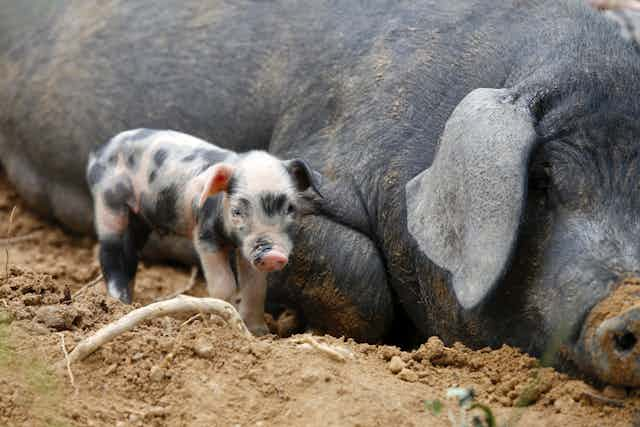Ever thought how the ingredients for that bacon sandwich got to your plate? By that, I mean the amazing historical journey that has transformed the animal and plant species we farm today into the huge global biomass that now feeds billions of us.
The shift from hunting and foraging to farming began some 12,000 years ago and was one of the most fundamental shifts in our own species’ evolutionary and cultural history. It set up exponential population growth and health consequences we still live with today. The animals and plants that underpin all this are those we changed forever through a phenomenon called “domestication”.
It’s an enigmatic process we still know little about. For decades, scientists (including Charles Darwin) have argued about how domestication works, with much ink being spilt contrasting the deliberate human role versus that of a natural biological process.

Back to that bacon sandwich. The pig was one of the first farmyard animals to be domesticated, and today pork is the most widely eaten meat across the globe. Pigs are also important for the pharmaceutical industry – they’re the source of more than 20 key drugs – while “transgenic” pigs can provide humans with heart-valve transplants and maybe in future entire organs.
So where did this illustrious farmyard animal’s domestic relationship with humans begin? Its ancestor the wild boar (Sus scrofa) is distributed across the vast majority of Europe and Asia, meaning it could have been domesticated almost anywhere. However, zooarchaeological evidence (the bones and teeth of animals) indicate pig domestication probably began in Eastern Turkey some 9-10,000 years ago and then, independently, several thousand years later in central China. Recent research matching DNA from wild boar populations to domestic pigs suggests pig domestication occurred in additional places across the Old World – including Europe.
Are pigs man-made?
Archaeologists traditionally thought humans directly intervened early in the process, isolating a few individuals from the local wild population. Once these “proto-domestic” animals were separated from their wild counterparts, the theory goes, there was no further significant breeding between the two. This should be especially true for pigs, since the re-introduction of “wild” traits back into domestic stock would be particularly undesirable – no farmer wants hairy pigs with attitude and dangerous tusks who keep wanting to escape.
This form of domestication should result in a genetic “bottleneck” – an evolutionary process not unlike that involved in the natural (or human-mediated) dispersal by mammals to remote islands. Then, over the next several generations of breeding and selection in this small group, the looks and behaviour that differentiate domestic from wild forms would appear.

Others, however, argue domestication was much more dynamic and fluid, occurring over a longer timescale and involving more-or less continuous gene flow between wild and domestic populations. They challenge claims of additional instances of pig domestication beyond the Near East and China, stating that genetic data could equally be explained by ongoing breeding with wild boar as domestic swineherds moved across Eurasia with early farmers.
Piecing pigs together
In a new paper published in Nature Genetics, researchers from Oxford and Wageningen University (Netherlands) have applied advanced modelling approaches to genomic data from pigs and wild boar in order to resolve these longstanding contradictory viewpoints. Their results are compelling and throw new light on the process of domestication.
First, the data shows modern-day domestic pigs to be a mosaic of different wild boar populations, supporting previous conclusions drawn from studies of modern and ancient DNA. Their results, however, don’t support previous claims for the existence of numerous other centres of pig domestication outside Western Asia and China. Their modelling of genomic data from Western Asia and Europe instead implies continuous and significant gene flow between wild boar and domestic pigs across these regions and, crucially, no evidence for a genetic bottleneck in European domestic pigs.

But how were the distinctive traits that differentiate wild and domestic forms of Sus scrofa maintained in the face of continued gene flow back and forth? The highly plausible explanation is that recurrent intentional or unintentional selection for similar traits somehow counteracted its effects, creating what the researchers calls “genomic islands of domestication” – that is, pigs in some regions were less affected by gene flow from wild boar.
These so-called genetic sweeps seem to have had the same affect on pig genomes in the two geographically isolated regions of the world where pigs were independently domesticated, hinting at a more fundamental underlying genetic and developmental basis for the process – perhaps involving a number of so called “domestication genes”.
This new genetic data is finally allowing us to move beyond questions about when, where and how many times pigs were domesticated, to how the process actually worked. Something to think about, next time you tuck into your bacon sandwich.

